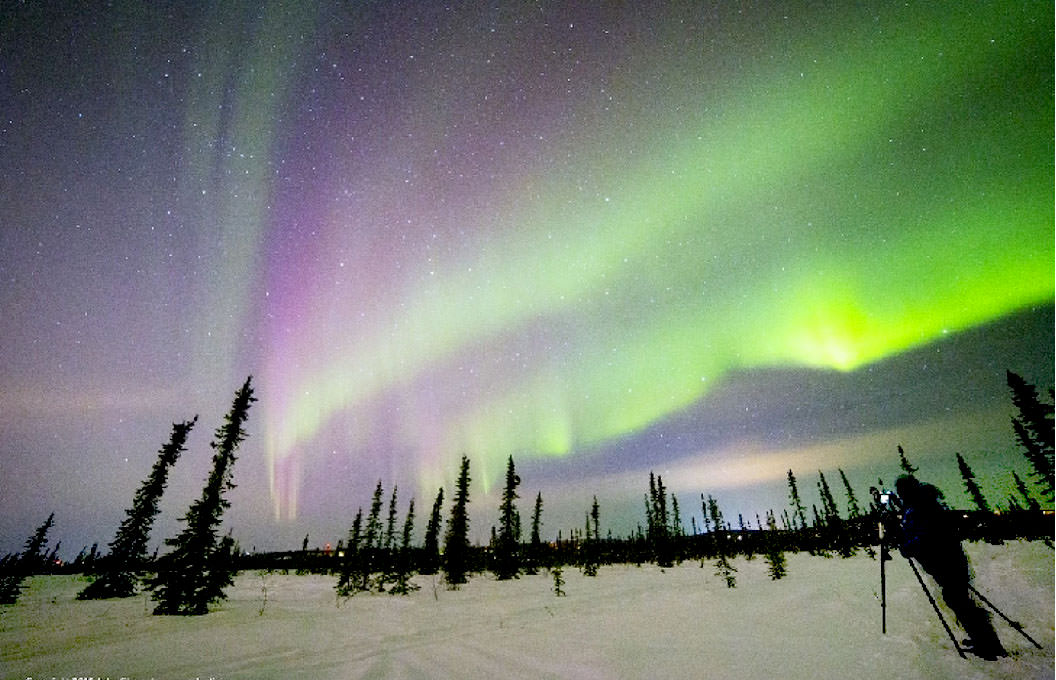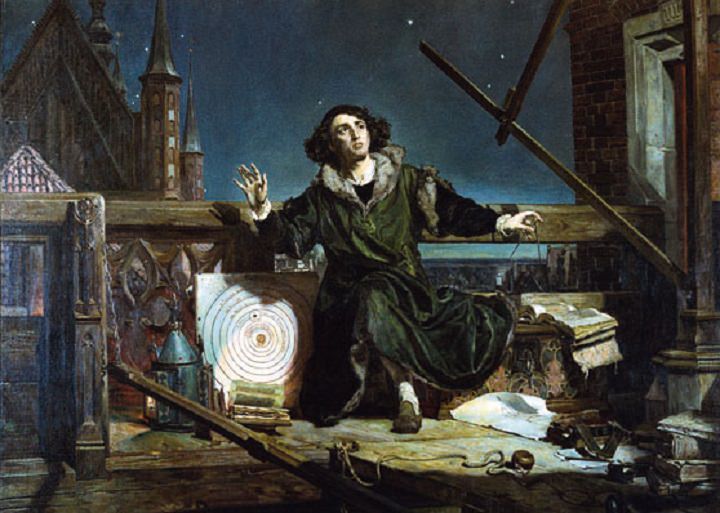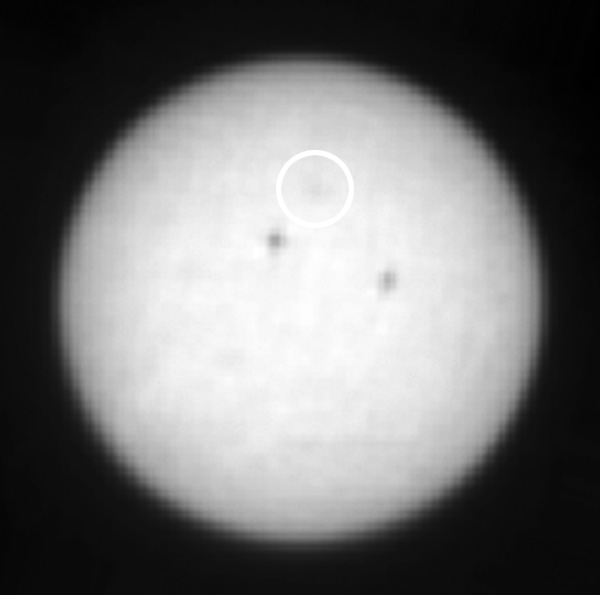The sun constantly cycles between periods of activity and periods of inactivity, and a new technique allows scientists to better predict when things will start getting interesting.
Continue reading “Scientists are much better at predicting when the Sun is going to become more active”Watch the Sun to Know When We’re Going to Have Killer Auroras
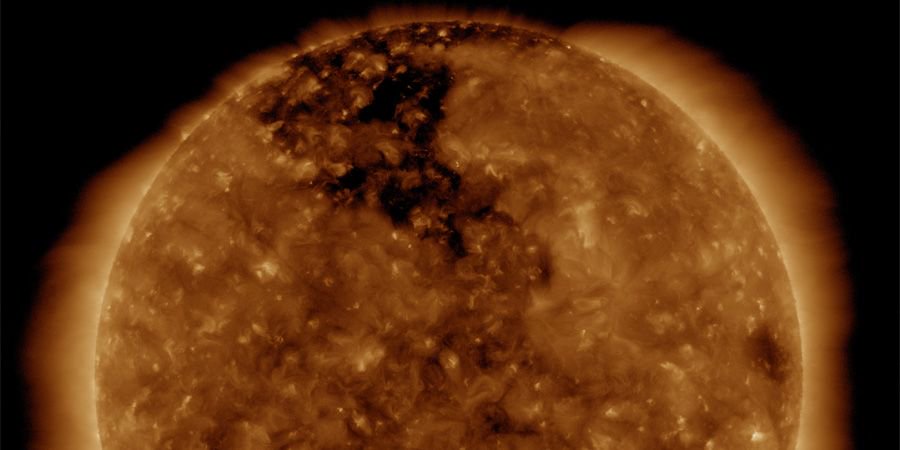
To the naked eye, the Sun puts out energy in a continual, steady state, unchanged through human history. (Don’t look at the sun with your naked eye!) But telescopes tuned to different parts of the electromagnetic spectrum reveal the Sun’s true nature: A shifting, dynamic ball of plasma with a turbulent life. And that dynamic, magnetic turbulence creates space weather.
Space weather is mostly invisible to us, but the part we can see is one of nature’s most stunning displays, the auroras. The aurora’s are triggered when energetic material from the Sun slams into the Earth’s magnetic field. The result is the shimmering, shifting bands of color seen at northern and southern latitudes, also known as the northern and southern lights.
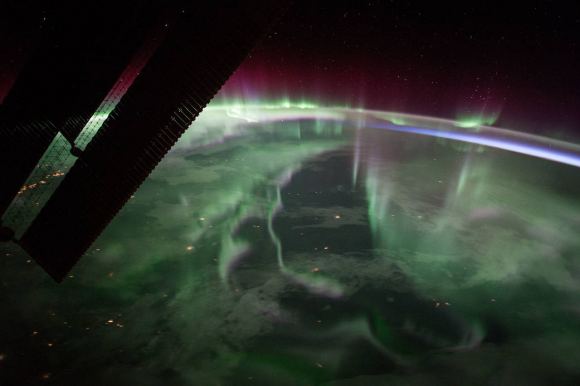
There are two things that can cause auroras, but both start with the Sun. The first involves solar flares. Highly-active regions on the Sun’s surface produce more solar flares, which are sudden, localized increase in the Sun’s brightness. Often, but not always, a solar flare is coupled with a coronal mass ejection (CME).
A coronal mass ejection is a discharge of matter and electromagnetic radiation into space. This magnetized plasma is mostly protons and electrons. The CME ejection often just disperses into space, but not always. If it’s aimed in the direction of the Earth, chances are we get increased auroral activity.
The second cause of auroras are coronal holes on the Sun’s surface. A coronal hole is a region on the surface of the Sun that is cooler and less dense than surrounding areas. Coronal holes are the source of fast-moving streams of material from the Sun.
Whether it’s from an active region on the Sun full of solar flares, or whether it’s from a coronal hole, the result is the same. When the discharge from the Sun strikes the charged particles in our own magnetosphere with enough force, both can be forced into our upper atmosphere. As they reach the atmosphere, they give up their energy. This causes constituents in our atmosphere to emit light. Anyone who has witnessed an aurora knows just how striking that light can be. The shifting and shimmering patterns of light are mesmerizing.
The auroras occur in a region called the auroral oval, which is biased towards the night side of the Earth. This oval is expanded by stronger solar emissions. So when we watch the surface of the Sun for increased activity, we can often predict brighter auroras which will be more visible in southern latitudes, due to the expansion of the auroral oval.

Something happening on the surface of the Sun in the last couple days could signal increased auroras on Earth, tonight and tomorrow (March 28th, 29th). A feature called a trans-equatorial coronal hole is facing Earth, which could mean that a strong solar wind is about to hit us. If it does, look north or south at night, depending on where your live, to see the auroras.
Of course, auroras are only one aspect of space weather. They’re like rainbows, because they’re very pretty, and they’re harmless. But space weather can be much more powerful, and can produce much greater effects than mere auroras. That’s why there’s a growing effort to be able to predict space weather by watching the Sun.
A powerful enough solar storm can produce a CME strong enough to damage things like power systems, navigation systems, communications systems, and satellites. The Carrington Event in 1859 was one such event. It produced one of the largest solar storms on record.
That storm occurred on September 1st and 2nd, 1859. It was preceded by an increase in sun spots, and the flare that accompanied the CME was observed by astronomers. The auroras caused by this storm were seen as far south as the Caribbean.
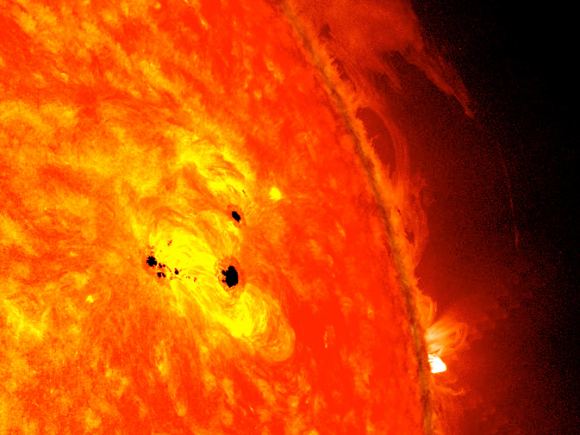
The same storm today, in our modern technological world, would wreak havoc. In 2012, we almost found out exactly how damaging a storm of that magnitude could be. A pair of CMEs as powerful as the Carrington Event came barreling towards Earth, but narrowly missed us.
We’ve learned a lot about the Sun and solar storms since 1859. We now know that the Sun’s activity is cyclical. Every 11 years, the Sun goes through its cycle, from solar maximum to solar minimum. The maximum and minimum correspond to periods of maximum sunspot activity and minimum sunspot activity. The 11 year cycle goes from minimum to minimum. When the Sun’s activity is at its minimum in the cycle, most CMEs come from coronal holes.
NASA’s Solar Dynamics Observatory (SDO), and the combined ESA/NASA Solar and Heliospheric Observatory (SOHO) are space observatories tasked with studying the Sun. The SDO focuses on the Sun and its magnetic field, and how changes influence life on Earth and our technological systems. SOHO studies the structure and behavior of the solar interior, and also how the solar wind is produced.
Several different websites allow anyone to check in on the behavior of the Sun, and to see what space weather might be coming our way. The NOAA’s Space Weather Prediction Center has an array of data and visualizations to help understand what’s going on with the Sun. Scroll down to the Aurora forecast to watch a visualization of expected auroral activity.
NASA’s Space Weather site contains all kinds of news about NASA missions and discoveries around space weather. SpaceWeatherLive.com is a volunteer run site that provides real-time info on space weather. You can even sign up to receive alerts for upcoming auroras and other solar activity.
How Can You see the Northern Lights?
The Northern Lights have fascinated human beings for millennia. In fact, their existence has informed the mythology of many cultures, including the Inuit, Northern Cree, and ancient Norse. They were also a source of intense fascination for the ancient Greeks and Romans, and were seen as a sign from God by medieval Europeans.
Thanks to the birth of modern astronomy, we now know what causes both the Aurora Borealis and its southern sibling – Aurora Australis. Nevertheless, they remain the subject of intense fascination, scientific research, and are a major tourist draw. For those who live north of 60° latitude, this fantastic light show is also a regular occurrence.
Causes:
Aurora Borealis (and Australis) is caused by interactions between energetic particles from the Sun and the Earth’s magnetic field. The invisible field lines of Earth’s magnetoshere travel from the Earth’s northern magnetic pole to its southern magnetic pole. When charged particles reach the magnetic field, they are deflected, creating a “bow shock” (so-named because of its apparent shape) around Earth.
However, Earth’s magnetic field is weaker at the poles, and some particles are therefore able to enter the Earth’s atmosphere and collide with gas particles in these regions. These collisions emit light that we perceive as wavy and dancing, and are generally a pale, yellowish-green in color.
The variations in color are due to the type of gas particles that are colliding. The common yellowish-green is produced by oxygen molecules located about 100 km (60 miles) above the Earth, whereas high-altitude oxygen – at heights of up to 320 km (200 miles) – produce all-red auroras. Meanwhile, interactions between charged particles and nitrogen will produces blue or purplish-red auroras.
Variability:
The visibility of the northern (and southern) lights depends on a lot of factors, much like any other type of meteorological activity. Though they are generally visible in the far northern and southern regions of the globe, there have been instances in the past where the lights were visible as close to the equator as Mexico.
In places like Alaska, Norther Canada, Norway and Siberia, the northern lights are often seen every night of the week in the winter. Though they occur year-round, they are only visible when it is rather dark out. Hence why they are more discernible during the months where the nights are longer.
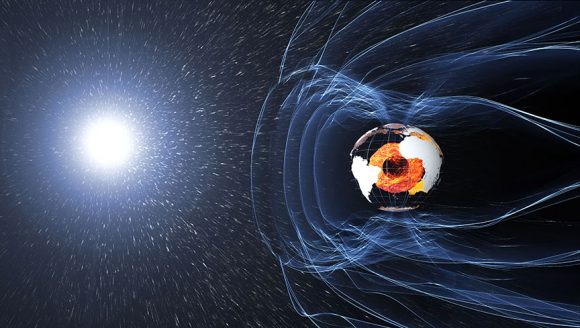
Because they depend on the solar wind, auroras are more plentiful during peak periods of activity in the Solar Cycle. This cycle takes places every 11 years, and is marked by the increase and decrease of sunspots on the sun’s surface. The greatest number of sunspots in any given solar cycle is designated as a “Solar Maximum“, whereas the lowest number is a “Solar Minimum.”
A Solar Maximum also accords with bright regions appearing in the Sun’s corona, which are rooted in the lower sunspots. Scientists track these active regions since they are often the origin of eruptions on the Sun, such as solar flares or coronal mass ejections.
The most recent solar minimum occurred in 2008. As of January 2010, the Sun’s surface began to increase in activity, which began with the release of a lower-intensity M-class flare. The Sun continued to get more active, culminating in a Solar Maximum by the summer of 2013.
Locations for Viewing:
The ideal places to view the Northern Lights are naturally located in geographical regions north of 60° latitude. These include northern Canada, Greenland, Iceland, Scandinavia, Alaska, and Northern Russia. Many organizations maintain websites dedicated to tracking optimal viewing conditions.
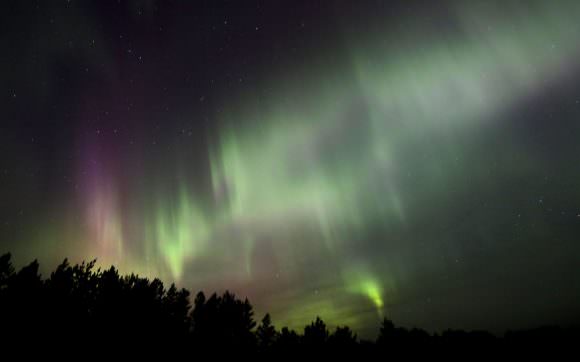
For instance, the Geophysical Institute of the University of Alaska Fairbanks maintains the Aurora Forecast. This site is regularly updated to let residents know when auroral activity is high, and how far south it will extend. Typically, residents who live in central or northern Alaska (from Fairbanks to Barrow) have a better chance than those living in the south (Anchorage to Juneau).
In Northern Canada, auroras are often spotted from the Yukon, the Northwest Territories, Nunavut, and Northern Quebec. However, they are sometimes seen from locations like Dawson Creek, BC; Fort McMurry, Alberta; northern Saskatchewan and the town of Moose Factory by James Bay, Ontario. For information, check out Canadian Geographic Magazine’s “Northern Lights Across Canada“.
The National Oceanic and Atmospheric Agency also provides 30 minute forecasts on auroras through their Space Weather Prediction Center. And then there’s Aurora Alert, an Android App that allows you to get regular updates on when and where an aurora will be visible in your region.
Understanding the scientific cause of auroras has not made them any less awe-inspiring or wondrous. Every year, countless people venture to locations where they can be seen. And for those serving aboard the ISS, they got the best seat in the house!
Speaking of which, be sure to check out this stunning NASA video which shows the Northern Lights being viewed from the ISS:
We have written many interesting articles about Auroras here at Universe Today. Here’s The Northern and Southern Lights – What is an Aurora?, What is the Aurora Borealis?, What is the Aurora Australis?, What Causes the Northern Lights?, How Does the Aurora Borealis Form?, and Watch Fast and Furious All-sky Aurora Filmed in Real Time.
For more information, visit the THEMIS website – a NASA mission that is currently studying space weather in great detail. The Space Weather Center has information on the solar wind and how it causes aurorae.
Astronomy Cast also has episodes on the subject, like Episode 42: Magnetism Everywhere.
Sources:
Weekly Space Hangout – Apr. 15, 2016: Dr. Howard Trottier
Host: Fraser Cain (@fcain)
Special Guest: Howard Trottier, a physics professor at Simon Fraser University (SFU) in British Columbia, Canada. Dr. Trottier has recently devoted his time to the development of SFU’s unique Astronomy public outreach program. In the heart of SFU’s main campus is a “”Science Courtyard,”” a high-profile public space devoted to astronomy and anchored by a state-of-the art outreach and teaching observatory. You can learn more about this amazing program here.
Guests:
Kimberly Cartier (@AstroKimCartier )
Dave Dickinson (www.astroguyz.com / @astroguyz)
Paul M. Sutter (pmsutter.com / @PaulMattSutter)
Their stories this week:
Breakthrough Starshot mission to Alpha Centauri program
Kepler spacecraft temporarily in emergency mode
We’ve had an abundance of news stories for the past few months, and not enough time to get to them all. So we’ve started a new system. Instead of adding all of the stories to the spreadsheet each week, we are now using a tool called Trello to submit and vote on stories we would like to see covered each week, and then Fraser will be selecting the stories from there. Here is the link to the Trello WSH page (http://bit.ly/WSHVote), which you can see without logging in. If you’d like to vote, just create a login and help us decide what to cover!
We record the Weekly Space Hangout every Friday at 12:00 pm Pacific / 3:00 pm Eastern. You can watch us live on Google+, Universe Today, or the Universe Today YouTube page.
You can also join in the discussion between episodes over at our Weekly Space Hangout Crew group in G+!
Who Was Galileo Galilei?
When it comes to scientists who revolutionized the way we think of the universe, few names stand out like Galileo Galilei. A noted inventor, physicist, engineer and astronomer, Galileo was one of the greatest contributors to the Scientific Revolution. He build telescopes, designed a compass for surveying and military use, created a revolutionary pumping system, and developed physical laws that were the precursors of Newton’s law of Universal Gravitation and Einstein’s Theory of Relativity.
But it was within the field of astronomy that Galileo made his most enduring impact. Using telescopes of his own design, he discovered Sunspots, the largest moons of Jupiter, surveyed The Moon, and demonstrated the validity of Copernicus’ heliocentric model of the universe. In so doing, he helped to revolutionize our understanding of the cosmos, our place in it, and helped to usher in an age where scientific reasoning trumped religious dogma.
Early Life:
Galileo was born in Pisa, Italy, in 1564, into a noble but poor family. He was the first of six children of Vincenzo Galilei and Giulia Ammannati, who’s father also had three children out of wedlock. Galileo was named after an ancestor, Galileo Bonaiuti (1370 – 1450), a noted physician, university teacher and politician who lived in Florence.
His father, a famous lutenist, composer and music theorist, had a great impact on Galileo; transmitting not only his talent for music, but skepticism of authority, the value of experimentation, and the value of measures of time and rhythm to achieve success.
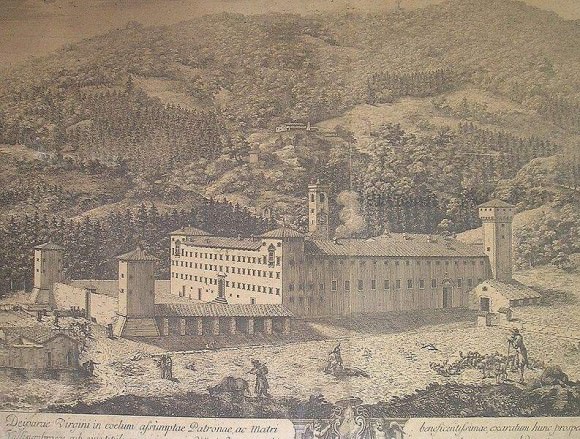
In 1572, when Galileo Galilei was eight, his family moved to Florence, leaving Galileo with his uncle Muzio Tedaldi (related to his mother through marriage) for two years.When he reached the age of ten, Galileo left Pisa to join his family in Florence and was tutored by Jacopo Borghini -a mathematician and professor from the university of Pisa.
Once he was old enough to be educated in a monastery, his parents sent him to the Camaldolese Monastery at Vallombrosa, located 35 km southeast of Florence. The Order was independent from the Benedictines, and combined the solitary life of the hermit with the strict life of a monk. Galileo apparently found this life attractive and intending to join the Order, but his father insisted that he study at the University of Pisa to become a doctor.
Education:
While at Pisa, Galileo began studying medicine, but his interest in the sciences quickly became evident. In 1581, he noticed a swinging chandelier, and became fascinated by the timing of its movements. To him, it became clear that the amount of time, regardless of how far it was swinging, was comparable to the beating of his heart.
When he returned home, he set up two pendulums of equal length, swinging one with a large sweep and the other with a small sweep, and found that they kept time together. These observations became the basis of his later work with pendulums to keep time – work which would also be picked up almost a century later when Christiaan Huygens designed the first officially-recognized pendulum clock.
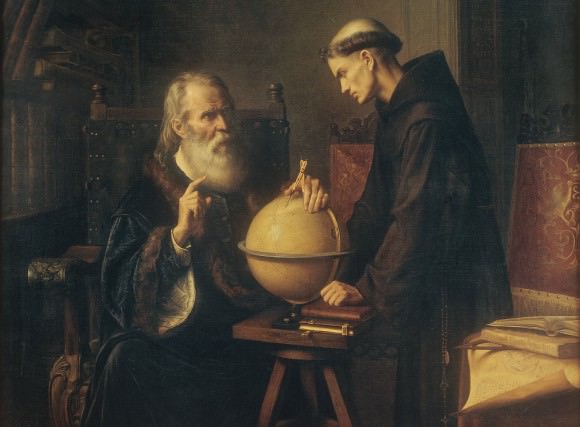
Shortly thereafter, Galileo accidentally attended a lecture on geometry, and talked his reluctant father into letting his study mathematics and natural philosophy instead of medicine. From that point onward, he began a steady processes of inventing, largely for the sake of appeasing his father’s desire for him to make money to pay off his siblings expenses (particularly those of his younger brother, Michelagnolo).
In 1589, Galileo was appointed to the chair of mathematics at the University of Pisa. In 1591, his father died, and he was entrusted with the care of his younger siblings. Being Professor of Mathematics at Pisa was not well paid, so Galileo lobbied for a more lucrative post. In 1592, this led to his appointment to the position of Professor of Mathematics at the University of Padua, where he taught Euclid’s geometry, mechanics, and astronomy until 1610.
During this period, Galileo made significant discoveries in both pure fundamental science as well as practical applied science. His multiple interests included the study of astrology, which at the time was a discipline tied to the studies of mathematics and astronomy. It was also while teaching the standard (geocentric) model of the universe that his interest in astronomy and the Copernican theory began to take off.
Telescopes:
In 1609, Galileo received a letter telling him about a spyglass that a Dutchman had shown in Venice. Using his own technical skills as a mathematician and as a craftsman, Galileo began to make a series of telescopes whose optical performance was much better than that of the Dutch instrument.

As he would later write in his 1610 tract Sidereus Nuncius (“The Starry Messenger”):
“About ten months ago a report reached my ears that a certain Fleming had constructed a spyglass by means of which visible objects, though very distant from the eye of the observer, were distinctly seen as if nearby. Of this truly remarkable effect several experiences were related, to which some persons believed while other denied them. A few days later the report was confirmed by a letter I received from a Frenchman in Paris, Jacques Badovere, which caused me to apply myself wholeheartedly to investigate means by which I might arrive at the invention of a similar instrument. This I did soon afterwards, my basis being the doctrine of refraction.”
His first telescope – which he constructed between June and July of 1609 – was made from available lenses and had a three-powered spyglass. To improve upon this, Galileo learned how to grind and polish his own lenses. By August, he had created an eight-powered telescope, which he presented to the Venetian Senate.
By the following October or November, he managed to improve upon this with the creation a twenty-powered telescope. Galileo saw a great deal of commercial and military applications of his instrument(which he called a perspicillum) for ships at sea. However, in 1610, he began turning his telescope to the heavens and made his most profound discoveries.
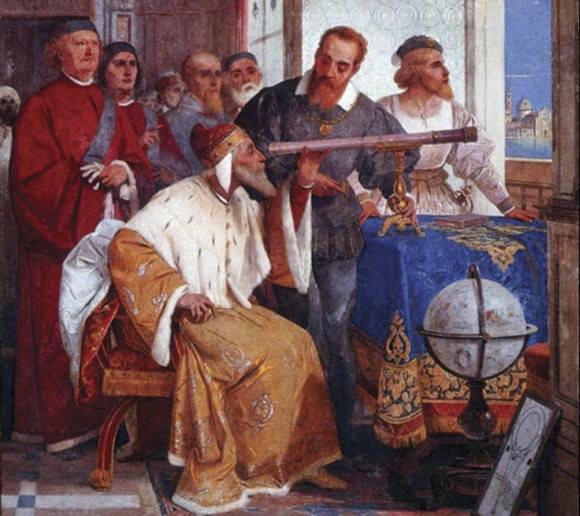
Achievements in Astronomy:
Using his telescope, Galileo began his career in astronomy by gazing at the Moon, where he discerned patterns of uneven and waning light. While not the first astronomer to do this, Galileo artistic’s training and knowledge of chiaroscuro – the use of strong contrasts between light and dark – allowed him to correctly deduce that these light patterns were the result of changes in elevation. Hence, Galileo was the first astronomer to discover lunar mountains and craters.
In The Starry Messenger, he also made topographical charts, estimating the heights of these mountains. In so doing, he challenged centuries of Aristotelian dogma that claimed that Moon, like the other planets, was a perfect, translucent sphere. By identifying that it had imperfections, in the forms of surface features, he began advancing the notion that the planets were similar to Earth.
Galileo also recorded his observations about the Milky Way in the Starry Messenger, which was previously believed to be nebulous. Instead, Galileo found that it was a multitude of stars packed so densely together that it appeared from a distance to look like clouds. He also reported that whereas the telescope resolved the planets into discs, the stars appeared as mere blazes of light, essentially unaltered in appearance by the telescope – thus suggesting that they were much farther away than previously thought.
Using his telescopes, Galileo also became one the first European astronomer to observe and study sunspots. Though there are records of previous instances of naked eye observations – such as in China (ca. 28 BCE), Anaxagoras in 467 BCE, and by Kepler in 1607 – they were not identifies as being imperfections on the surface of the Sun. In many cases, such as Kepler’s, it was thought that the spots were transits of Mercury.
In addition, there is also controversy over who was the first to observe sunspots during the 17th century using a telescope. Whereas Galileo is believed to have observed them in 1610, he did not publish about them and only began speaking to astronomers in Rome about them by the following year. In that time, German astronomer Christoph Scheiner had been reportedly observing them using a helioscope of his own design.
At around the same time, the Frisian astronomers Johannes and David Fabricius published a description of sunspots in June 1611. Johannes book, De Maculis in Sole Observatis (“On the Spots Observed in the Sun”) was published in autumn of 1611, thus securing credit for him and his father.
In any case, it was Galileo who properly identified sunspots as imperfections on the surface of the Sun, rather than being satellites of the Sun – an explanation that Scheiner, a Jesuit missionary, advanced in order to preserve his beliefs in the perfection of the Sun.
Using a technique of projecting the Sun’s image through the telescope onto a piece of paper, Galileo deduced that sunspots were, in fact, on the surface of the Sun or in its atmosphere. This presented another challenge to the Aristotelian and Ptolemaic view of the heavens, since it demonstrated that the Sun itself had imperfections.
On January 7th, 1610, Galileo pointed his telescope towards Jupiter and observed what he described in Nuncius as “three fixed stars, totally invisible by their smallness” that were all close to Jupiter and in line with its equator. Observations on subsequent nights showed that the positions of these “stars” had changed relative to Jupiter, and in a way that was not consistent with them being part of the background stars.
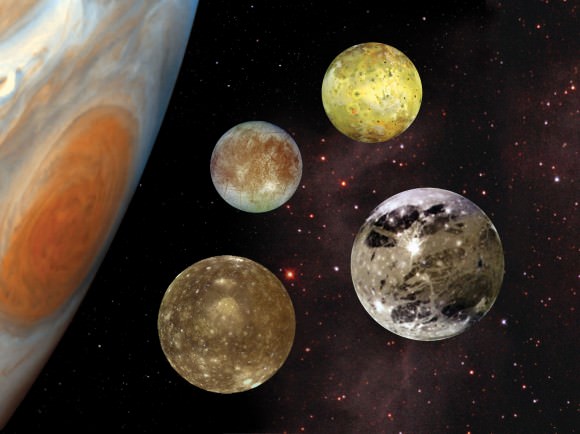
By January 10th, he noted that one had disappeared, which he attributed to it being hidden behind Jupiter. From this, he concluded that the stars were in fact orbiting Jupiter, and they were satellites of it. By January 13th, he discovered a fourth, and named them the Medicean stars, in honor of his future patron, Cosimo II de’ Medici, Grand Duke of Tuscany, and his three brothers.
Later astronomers, however, renamed them the Galilean Moons in honour of their discoverer. By the 20th century, these satellites would come to be known by their current names – Io, Europa, Ganymede, and Callisto – which had been suggested by 17th century German astronomer Simon Marius, apparently at the behest of Johannes Kepler.
Galileo’s observations of these satellites proved to be another major controversy. For the first time, a planet other than Earth was shown to have satellites orbiting it, which constituted yet another nail in the coffin of the geocentric model of the universe. His observations were independently confirmed afterwards, and Galileo continued to observe the satellites them and even obtained remarkably accurate estimates for their periods by 1611.
Heliocentrism:
Galileo’s greatest contribution to astronomy came in the form of his advancement of the Copernican model of the universe (i.e. heliocentrism). This began in 1610 with his publication of Sidereus Nuncius, which brought the issue of celestial imperfections before a wider audience. His work on sunspots and his observation of the Galilean Moons furthered this, revealing yet more inconsistencies in the currently accepted view of the heavens.
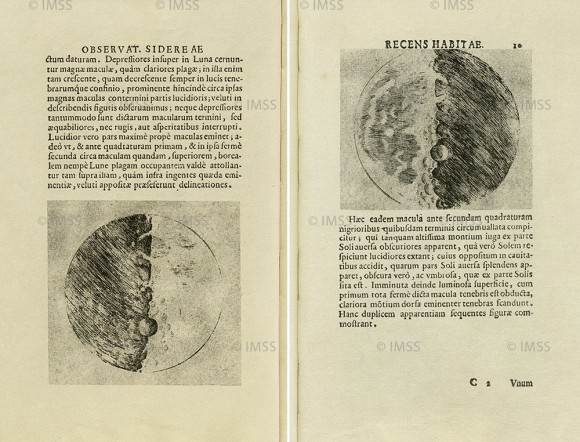
Other astronomical observations also led Galileo to champion the Copernican model over the traditional Aristotelian-Ptolemaic (aka. geocentric) view. From September 1610 onward, Galileo began observing Venus, noting that it exhibited a full set of phases similar to that of the Moon. The only explanation for this was that Venus was periodically between the Sun and Earth; while at other times, it was on the opposite side of the Sun.
According to the geocentric model of the universe, this should have been impossible, as Venus’ orbit placed it closer to Earth than the Sun – where it could only exhibit crescent and new phases. However, Galileo’s observations of it going through crescent, gibbous, full and new phases was consistent with the Copernican model, which established that Venus orbited the Sun within the Earth’s orbit.
These and other observations made the Ptolemaic model of the universe untenable. Thus, by the early 17th century, the great majority of astronomers began to convert to one of the various geo-heliocentric planetary models – such as the Tychonic, Capellan and Extended Capellan models. These all had the virtue of explaining problems in the geocentric model without engaging in the “heretical” notion that Earth revolved around the Sun.
In 1632, Galileo addressed the “Great Debate” in his treatise Dialogo sopra i due massimi sistemi del mondo (Dialogue Concerning the Two Chief World Systems), in which he advocated the heliocentric model over the geocentric. Using his own telescopic observations, modern physics and rigorous logic, Galileo’s arguments effectively undermined the basis of Aristotle and Ptolemy’s system for a growing and receptive audience.
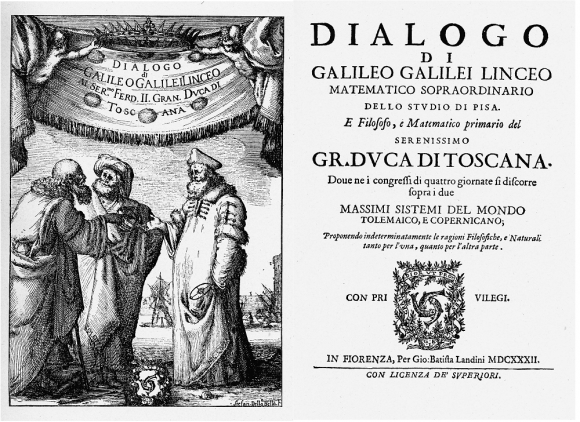
In the meantime, Johannes Kepler correctly identified the sources of tides on Earth – something which Galileo had become interesting in himself. But whereas Galileo attributed the ebb and flow of tides to the rotation of the Earth, Kepler ascribed this behavior to the influence of the Moon.
Combined with his accurate tables on the elliptical orbits of the planets (something Galileo rejected), the Copernican model was effectively proven. From the middle of the seventeenth century onward, there were few astronomers who were not Copernicans.
The Inquisition and House Arrest:
As a devout Catholic, Galileo often defended the heliocentric model of the universe using Scripture. In 1616, he wrote a letter to the Grand Duchess Christina, in which he argued for a non-literal interpretation of the Bible and espoused his belief in the heliocentric universe as a physical reality:
“I hold that the Sun is located at the center of the revolutions of the heavenly orbs and does not change place, and that the Earth rotates on itself and moves around it. Moreover … I confirm this view not only by refuting Ptolemy’s and Aristotle’s arguments, but also by producing many for the other side, especially some pertaining to physical effects whose causes perhaps cannot be determined in any other way, and other astronomical discoveries; these discoveries clearly confute the Ptolemaic system, and they agree admirably with this other position and confirm it.“
More importantly, he argued that the Bible is written in the language of the common person who is not an expert in astronomy. Scripture, he argued, teaches us how to go to heaven, not how the heavens go.
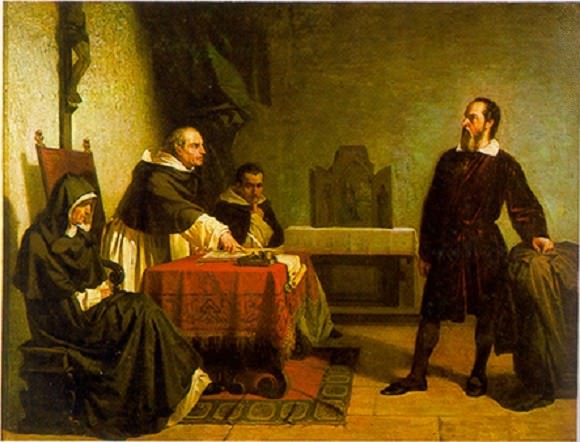
Initially, the Copernican model of the universe was not seen as an issue by the Roman Catholic Church or it’s most important interpreter of Scripture at the time – Cardinal Robert Bellarmine. However, in the wake of the Counter-Reformation, which began in 1545 in response to the Reformation, a more stringent attitude began to emerge towards anything seen as a challenge to papal authority.
Eventually, matters came to a head in 1615 when Pope Paul V (1552 – 1621) ordered that the Sacred Congregation of the Index (an Inquisition body charged with banning writings deemed “heretical”) make a ruling on Copernicanism. They condemned the teachings of Copernicus, and Galileo (who had not been personally involved in the trial) was forbidden to hold Copernican views.
However, things changed with the election of Cardinal Maffeo Barberini (Pope Urban VIII) in 1623. As a friend and admirer of Galileo’s, Barberini opposed the condemnation of Galileo, and gave formal authorization and papal permission for the publication of Dialogue Concerning the Two Chief World Systems.
However, Barberini stipulated that Galileo provide arguments for and against heliocentrism in the book, that he be careful not to advocate heliocentrism, and that his own views on the matter be included in Galileo’s book. Unfortunately, Galileo’s book proved to be a solid endorsement of heliocentrism and offended the Pope personally.
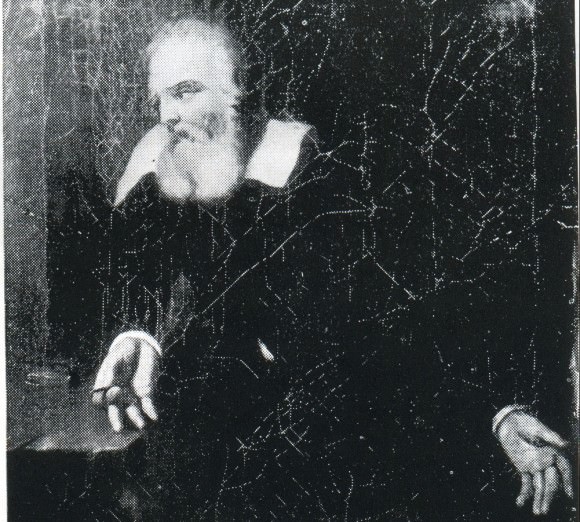
In it, the character of Simplicio, the defender of the Aristotelian geocentric view, is portrayed as an error-prone simpleton. To make matter worse, Galileo had the character Simplicio enunciate the views of Barberini at the close of the book, making it appear as though Pope Urban VIII himself was a simpleton and hence the subject of ridicule.
As a result, Galileo was brought before the Inquisition in February of 1633 and ordered to renounce his views. Whereas Galileo steadfastly defended his position and insisted on his innocence, he was eventually threatened with torture and declared guilty. The sentence of the Inquisition, delivered on June 22nd, contained three parts – that Galileo renounce Copernicanism, that he be placed under house arrest, and that the Dialogue be banned.
According to popular legend, after recanting his theory publicly that the Earth moved around the Sun, Galileo allegedly muttered the rebellious phrase: “E pur si muove” (“And yet it moves” in Latin). After a period of living with his friend, the Archbishop of Siena, Galileo returned to his villa at Arcetri (near Florence in 1634), where he spent the remainder of his life under house arrest.
Other Accomplishments:
In addition to his revolutionary work in astronomy and optics, Galileo is also credited with the invention of many scientific instruments and theories. Much of the devices he created were for the specific purpose of earning money to pay for his sibling’s expenses. However, they would also prove to have a profound impact in the fields of mechanics, engineering, navigation, surveying, and warfare.

In 1586, at the age of 22, Galileo made his first groundbreaking invention. Inspired by the story of Archimedes and his “Eureka” moment, Galileo began looking into how jewelers weighed precious metals in air and then by displacement to determine their specific gravity. Working from this, he eventually theorized of a better method, which he described in a treatise entitled La Bilancetta (“The Little Balance”).
In this tract, he described an accurate balance for weighing things in air and water, in which the part of the arm on which the counter weight was hung was wrapped with metal wire. The amount by which the counterweight had to be moved when weighing in water could then be determined very accurately by counting the number of turns of the wire. In so doing, the proportion of metals like gold to silver in the object could be read off directly.
In 1592, when Galileo was a professor of mathematics at the University of Padua, he made frequent trips to the Arsenal – the inner harbor where Venetian ships were outfitted. The Arsenal had been a place of practical invention and innovation for centuries, and Galileo used the opportunity to study mechanical devices in detail.
In 1593, he was consulted on the placement of oars in galleys and submitted a report in which he treated the oar as a lever and correctly made the water the fulcrum. A year later the Venetian Senate awarded him a patent for a device for raising water that relied on a single horse for the operation. This became the basis of modern pumps.
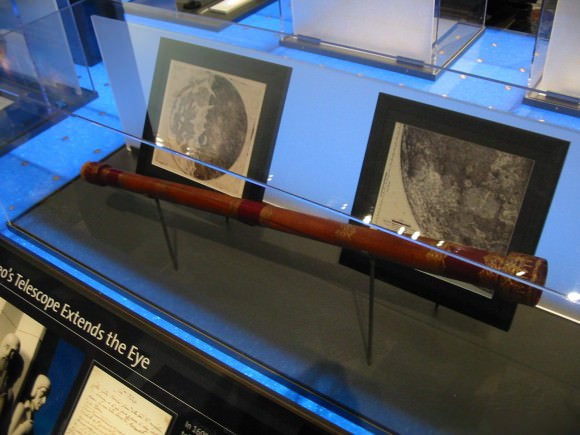
To some, Galileo’s Pump was a merely an improvement on the Archimedes Screw, which was first developed in the third century BCE and patented in the Venetian Republic in 1567. However, there is no apparent evidence connecting Galileo’s invention to Archimedes’ earlier and less sophisticated design.
In ca. 1593, Galileo constructed his own version of a thermoscope, a forerunner of the thermometer, that relied on the expansion and contraction of air in a bulb to move water in an attached tube. Over time, he and his colleagues worked to develop a numerical scale that would measure the heat based on the expansion of the water inside the tube.
The cannon, which was first introduced to Europe in 1325, had become a mainstay of war by Galileo’s time. Having become more sophisticated and mobile, gunners needed instruments to help them coordinate and calculate their fire. As such, between 1595 and 1598, Galileo devised an improved geometric and military compass for use by gunners and surveyors.
During the 16th century, Aristotelian physics was still the predominant way of explaining the behavior of bodies near the Earth. For example, it was believed that heavy bodies sought their natural place of rest – i.e at the center of things. As a result, no means existed to explain the behavior of pendulums, where a heavy body suspended from a rope would swing back and forth and not seek rest in the middle.

Already, Galileo had conducted experiments that demonstrated that heavier bodies did not fall faster than lighter ones – another belief consistent with Aristotelian theory. In addition, he also demonstrated that objects thrown into the air travel in parabolic arcs. Based on this and his fascination with the back and forth motion of a suspended weight, he began to research pendulums in 1588.
In 1602, he explained his observations in a letter to a friend, in which he described the principle of isochronism. According to Galileo, this principle asserted that the time it takes for the pendulum to swing is not linked to the arc of the pendulum, but rather the pendulum’s length. Comparing two pendulum’s of similar length, Galileo demonstrated that they would swing at the same speed, despite being pulled at different lengths.
According to Vincenzo Vivian, one of Galileo’s contemporaries, it was in 1641 while under house arrest that Galileo created a design for a pendulum clock. Unfortunately, being blind at the time, he was unable to complete it before his death in 1642. As a result, Christiaan Huygens’ publication of Horologrium Oscillatorium in 1657 is recognized as the first recorded proposal for a pendulum clock.
Death and Legacy:
Galileo died on January 8th, 1642, at the age of 77, due to fever and heart palpitations that had taken a toll on his health. The Grand Duke of Tuscany, Ferdinando II, wished to bury him in the main body of the Basilica of Santa Croce, next to the tombs of his father and other ancestors, and to erect a marble mausoleum in his honor.
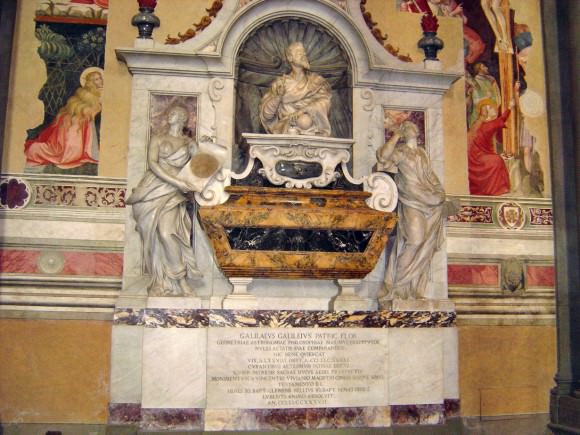
However, Pope Urban VIII objected on the basis that Galileo had been condemned by the Church, and his body was instead buried in a small room next to the novice’s chapel in the Basilica. However, after his death, the controversy surrounding his works and heliocentricm subsided, and the Inquisitions ban on his writing’s was lifted in 1718.
In 1737, his body was exhumed and reburied in the main body of the Basilica after a monument had been erected in his honor. During the exhumation, three fingers and a tooth were removed from his remains. One of these fingers, the middle finger from Galileo’s right hand, is currently on exhibition at the Museo Galileo in Florence, Italy.
In 1741, Pope Benedict XIV authorized the publication of an edition of Galileo’s complete scientific works which included a mildly censored version of the Dialogue. In 1758, the general prohibition against works advocating heliocentrism was removed from the Index of prohibited books, although the specific ban on uncensored versions of the Dialogue and Copernicus’s De Revolutionibus orbium coelestium (“On the Revolutions of the Heavenly Spheres“) remained.
All traces of official opposition to heliocentrism by the church disappeared in 1835 when works that espoused this view were finally dropped from the Index. And in 1939, Pope Pius XII described Galileo as being among the “most audacious heroes of research… not afraid of the stumbling blocks and the risks on the way, nor fearful of the funereal monuments”.
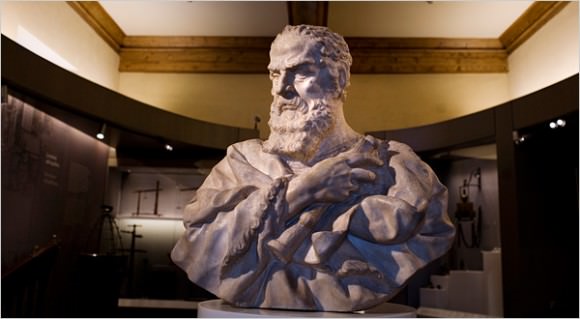
On October 31st, 1992, Pope John Paul II expressed regret for how the Galileo affair was handled, and issued a declaration acknowledging the errors committed by the Catholic Church tribunal. The affair had finally been put to rest and Galileo exonerated, though certain unclear statements issued by Pope Benedict XVI have led to renewed controversy and interest in recent years.
Alas, when it comes to the birth of modern science and those who helped create it, Galileo’s contributions are arguably unmatched. According to Stephen Hawking and Albert Einstein, Galileo was the father of modern science, his discoveries and investigations doing more to dispel the prevailing mood of superstition and dogma than anyone else in his time.
These include the discovery of craters and mountains on the Moon, the discovery of the four largest moons of Jupiter (Io, Europa, Ganymede and Callisto), the existence and nature of Sunspots, and the phases of Venus. These discoveries, combined with his logical and energetic defense of the Copernican model, made a lasting impact on astronomy and forever changed the way people look at the universe.
Galileo’s theoretical and experimental work on the motions of bodies, along with the largely independent work of Kepler and René Descartes, was a precursor of the classical mechanics developed by Sir Isaac Newton. His work with pendulums and time-keeping also previewed the work of Christiaan Huygens and the development of the pendulum clock, the most accurate timepiece of its day.
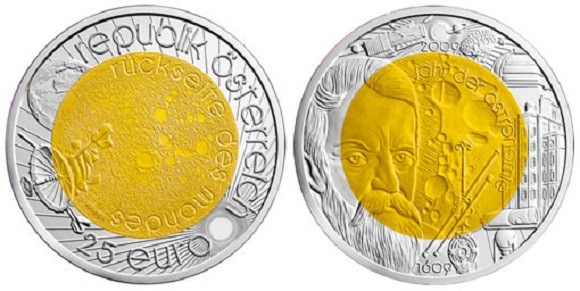
Galileo also put forward the basic principle of relativity, which states that the laws of physics are the same in any system that is moving at a constant speed in a straight line. This remains true, regardless of the system’s particular speed or direction, thus proving that there is no absolute motion or absolute rest. This principle provided the basic framework for Newton’s laws of motion and is central to Einstein’s special theory of relativity.
The United Nations chose 2009 to be the International Year of Astronomy, a global celebration of astronomy and its contributions to society and culture. The year 2009 was selected in part because it was the four-hundredth anniversary of Galileo first viewing the heavens with his a telescope he built himself.
A commemorative €25 coin was minted for the occasion, with the inset on the obverse side showing Galileo’s portrait and telescope, as well as one of his first drawings of the surface of the moon. In the silver circle that surrounds it, pictures of other telescopes – Isaac Newton’s Telescope, the observatory in Kremsmünster Abbey, a modern telescope, a radio telescope and a space telescope – are also shown.
Other scientific endeavors and principles are named after Galileo, including the NASA Galileo spacecraft, which was the first spacecraft to enter orbit around Jupiter. Operating from 1989 to 2003, the mission consisted of an orbiter that observed the Jovian system, and an atmospheric probe that made the first measurements of Jupiter’s atmosphere.
This mission found evidence of subsurface oceans on Europa, Ganymede and Callisto, and revealed the intensity of volcanic activity on Io. In 2003, the spacecraft was crashed into Jupiter’s atmosphere to avoid contamination of any of Jupiter’s moons.
The European Space Agency (ESA) is also developing a global satellite navigation system named Galileo. And in classical mechanics, the transformation between inertial systems is known as “Galilean Transformation“, which is denoted by the non-SI unit of acceleration Gal (sometimes known as the Galileo). Asteroid 697 Galilea is also named in his honor.
Yes, the sciences and humanity as a whole owes a great dept to Galileo. And as time goes on, and space exploration continues, it is likely we will continue to repay that debt by naming future missions – and perhaps even features on the Galilean Moons, should we ever settle there – after him. Seems like a small recompense for ushering in the age of modern science, no?
Universe Today has many interesting articles on Galileo, include the Galilean moons, Galileo’s inventions, and Galileo’s telescope.
For more information, check out the the Galileo Project and Galileo’s biography.
Astronomy Cast has an episode on choosing and using a telescope, and one which deals with the Galileo Spacecraft.
Who Was Nicolaus Copernicus?
When it comes to understanding our place in the universe, few scientists have had more of an impact than Nicolaus Copernicus. The creator of the Copernican Model of the universe (aka. heliocentrism), his discovery that the Earth and other planets revolved the Sun triggered an intellectual revolution that would have far-reaching consequences.
In addition to playing a major part in the Scientific Revolution of the 17th and 18th centuries, his ideas changed the way people looked at the heavens, the planets, and would have a profound influence over men like Johannes Kepler, Galileo Galilei, Sir Isaac Newton and many others. In short, the “Copernican Revolution” helped to usher in the era of modern science.
Copernicus’ Early Life:
Copernicus was born on February 19th, 1473 in the city of Torun (Thorn) in the Crown of the Kingdom of Poland. The youngest of four children to a well-to-do merchant family, Copernicus and his siblings were raised in the Catholic faith and had many strong ties to the Church.
His older brother Andreas would go on to become an Augustinian canon, while his sister, Barbara, became a Benedictine nun and (in her final years) the prioress of a convent. Only his sister Katharina ever married and had children, which Copernicus looked after until the day he died. Copernicus himself never married or had any children of his own.

Born in a predominately Germanic city and province, Copernicus acquired fluency in both German and Polish at a young age, and would go on to learn Greek and Italian during the course of his education. Given that it was the language of academia in his time, as well as the Catholic Church and the Polish royal court, Copernicus also became fluent in Latin, which the majority of his surviving works are written in.
Copernicus’ Education:
In 1483, Copernicus’ father (whom he was named after) died, whereupon his maternal uncle, Lucas Watzenrode the Younger, began to oversee his education and career. Given the connections he maintained with Poland’s leading intellectual figures, Watzenrode would ensure that Copernicus had great deal of exposure to some of the intellectual figures of his time.
Although little information on his early childhood is available, Copernicus’ biographers believe that his uncle sent him to St. John’ School in Torun, where he himself had been a master. Later, it is believed that he attended the Cathedral School at Wloclawek (located 60 km south-east Torun on the Vistula River), which prepared pupils for entrance to the University of Krakow – Watzenrode’s own Alma mater.
In 1491, Copernicus began his studies in the Department of Arts at the University of Krakow. However, he quickly became fascinated by astronomy, thanks to his exposure to many contemporary philosophers who taught or were associated with the Krakow School of Mathematics and Astrology, which was in its heyday at the time.

Copernicus’ studies provided him with a thorough grounding in mathematical-astronomical knowledge, as well as the philosophy and natural-science writings of Aristotle, Euclid, and various humanist writers. It was while at Krakow that Copernicus began collecting a large library on astronomy, and where he began his analysis of the logical contradictions in the two most popular systems of astronomy.
These models – Aristotle’s theory of homocentric spheres, and Ptolemy’s mechanism of eccentrics and epicycles – were both geocentric in nature. Consistent with classical astronomy and physics, they espoused that the Earth was at the center of the universe, and that the Sun, the Moon, the other planets, and the stars all revolved around it.
Before earning a degree, Copernicus left Krakow (ca. 1495) to travel to the court of his uncle Watzenrode in Warmia, a province in northern Poland. Having been elevated to the position of Prince-Bishop of Warmia in 1489, his uncle sought to place Copernicus in the Warmia canonry. However, Copernicus’ installation was delayed, which prompted his uncle to send him and his brother to study in Italy to further their ecclesiastic careers.
In 1497, Copernicus arrived in Bologna and began studying at the Bologna University of Jurists’. While there, he studied canon law, but devoted himself primarily to the study of the humanities and astronomy. It was also while at Bologna that he met the famous astronomer Domenico Maria Novara da Ferrara and became his disciple and assistant.

Over time, Copernicus’ began to feel a growing sense of doubt towards the Aristotelian and Ptolemaic models of the universe. These included the problematic explanations arising from the inconsistent motion of the planets (i.e. retrograde motion, equants, deferents and epicycles), and the fact that Mars and Jupiter appeared to be larger in the night sky at certain times than at others.
Hoping to resolve this, Copernicus used his time at the university to study Greek and Latin authors (i.e. Pythagoras, Cicero, Pliny the Elder, Plutarch, Heraclides and Plato) as well as the fragments of historic information the university had on ancient astronomical, cosmological and calendar systems – which included other (predominantly Greek and Arab) heliocentric theories.
In 1501, Copernicus moved to Padua, ostensibly to study medicine as part of his ecclesiastical career. Just as he had done at Bologna, Copernicus carried out his appointed studies, but remained committed to his own astronomical research. Between 1501 and 1503, he continued to study ancient Greek texts; and it is believed that it was at this time that his ideas for a new system of astronomy – whereby the Earth itself moved – finally crystallized.
The Copernican Model (aka. Heliocentrism):
In 1503, having finally earned his doctorate in canon law, Copernicus returned to Warmia where he would spend the remaining 40 years of his life. By 1514, he began making his Commentariolus (“Little Commentary”) available for his friends to read. This forty-page manuscript described his ideas about the heliocentric hypothesis, which was based on seven general principles.
These seven principles stated that: Celestial bodies do not all revolve around a single point; the center of Earth is the center of the lunar sphere—the orbit of the moon around Earth; all the spheres rotate around the Sun, which is near the center of the Universe; the distance between Earth and the Sun is an insignificant fraction of the distance from Earth and Sun to the stars, so parallax is not observed in the stars; the stars are immovable – their apparent daily motion is caused by the daily rotation of Earth; Earth is moved in a sphere around the Sun, causing the apparent annual migration of the Sun; Earth has more than one motion; and Earth’s orbital motion around the Sun causes the seeming reverse in direction of the motions of the planets.

Thereafter he continued gathering data for a more detailed work, and by 1532, he had come close to completing the manuscript of his magnum opus – De revolutionibus orbium coelestium (On the Revolutions of the Heavenly Spheres). In it, he advanced his seven major arguments, but in more detailed form and with detailed computations to back them up.
However, due to fears that the publication of his theories would lead to condemnation from the church (as well as, perhaps, worries that his theory presented some scientific flaws) he withheld his research until a year before he died. It was only in 1542, when he was near death, that he sent his treatise to Nuremberg to be published.
Copernicus’ Death:
Towards the end of 1542, Copernicus suffered from a brain hemorrhage or stroke which left him paralyzed. On May 24th, 1543, he died at the age of 70 and was reportedly buried in the Frombork Cathedral in Frombork, Poland. It is said that on the day of his death, May 24th 1543 at the age of 70, he was presented with an advance copy of his book, which he smiled upon before passing away.
In 2005, an archaeological team conducted a scan of the floor of Frombork Cathedral, declaring that they had found Copernicus’ remains. Afterwards, a forensic expert from the Polish Police Central Forensic Laboratory used the unearthed skull to reconstruct a face that closely resembled Copernicus’ features. The expert also determined that the skull belonged to a man who had died around age 70 – Copernicus’ age at the time of his death.
These findings were backed up in 2008 when a comparative DNA analysis was made from both the remains and two hairs found in a book Copernicus was known to have owned (Calendarium Romanum Magnum, by Johannes Stoeffler). The DNA results were a match, proving that Copernicus’ body had indeed been found.

On May 22nd, 2010, Copernicus was given a second funeral in a Mass led by Józef Kowalczyk, the former papal nuncio to Poland and newly named Primate of Poland. Copernicus’ remains were reburied in the same spot in Frombork Cathedral, and a black granite tombstone (shown above) now identifies him as the founder of the heliocentric theory and also a church canon. The tombstone bears a representation of Copernicus’ model of the solar system – a golden sun encircled by six of the planets.
Copernicus’ Legacy:
Despite his fears about his arguments producing scorn and controversy, the publication of his theories resulted in only mild condemnation from religious authorities. Over time, many religious scholars tried to argue against his model, using a combination of Biblical canon, Aristotelian philosophy, Ptolemaic astronomy, and then-accepted notions of physics to discredit the idea that the Earth itself would be capable of motion.
However, within a few generation’s time, Copernicus’ theory became more widespread and accepted, and gained many influential defenders in the meantime. These included Galileo Galilei (1564-1642), who’s investigations of the heavens using the telescope allowed him to resolve what were seen at the time as flaws in the heliocentric model.
These included the relative changes in the appearances of Mars and Jupiter when they are in opposition vs. conjunction to the Earth. Whereas they appear larger to the naked eye than Copernicus’ model suggested they should, Galileo proved that this is an illusion caused by the behavior of light at a distance, and can be resolved with a telescope.

Through the use of the telescope, Galileo also discovered moons orbiting Jupiter, Sunspots, and the imperfections on the Moon’s surface, all of which helped to undermine the notion that the planets were perfect orbs, rather than planets similar to Earth. While Galileo’s advocacy of Copernicus’ theories resulted in his house arrest, others soon followed.
German mathematician and astronomer Johannes Kepler (1571-1630) also helped to refine the heliocentric model with his introduction of elliptical orbits. Prior to this, the heliocentric model still made use of circular orbits, which did not explain why planets orbited the Sun at different speeds at different times. By showing how the planet’s sped up while at certain points in their orbits, and slowed down in others, Kepler resolved this.
In addition, Copernicus’ theory about the Earth being capable of motion would go on to inspire a rethinking of the entire field of physics. Whereas previous ideas of motion depended on an outside force to instigate and maintain it (i.e. wind pushing a sail) Copernicus’ theories helped to inspire the concepts of gravity and inertia. These ideas would be articulated by Sir Isaac Newton, who’s Principia formed the basis of modern physics and astronomy.
Today, Copernicus is honored (along with Johannes Kepler) by the liturgical calendar of the Episcopal Church (USA) with a feast day on May 23rd. In 2009, the discoverers of chemical element 112 (which had previously been named ununbium) proposed that the International Union of Pure and Applied Chemistry rename it copernicum (Cn) – which they did in 2011.

In 1973, on the 500th anniversary of his birthday, the Federal Republic of Germany (aka. West Germany) issued a 5 Mark silver coin (shown above) that bore Copernicus’ name and a representation of the heliocentric universe on one side.
In August of 1972, the Copernicus – an Orbiting Astronomical Observatory created by NASA and the UK’s Science Research Council – was launched to conduct space-based observations. Originally designated OAO-3, the satellite was renamed in 1973 in time for the 500th anniversary of Copernicus’ birth. Operating until February of 1981, Copernicus proved to be the most successful of the OAO missions, providing extensive X-ray and ultraviolet information on stars and discovering several long-period pulsars.
Two craters, one located on the Moon, the other on Mars, are named in Copernicus’ honor. The European Commission and the European Space Agency (ESA) is currently conducting the Copernicus Program. Formerly known as Global Monitoring for Environment and Security (GMES), this program aims at achieving an autonomous, multi-level operational Earth observatory.
On February 19th, 2013, the world celebrated the 540th anniversary of Copernicus’ birthday. Even now, almost five and a half centuries later, he is considered one of the greatest astronomers and scientific minds that ever lived. In addition to revolutionizing the fields of physics, astronomy, and our very concept of the laws of motion, the tradition of modern science itself owes a great debt to this noble scholar who placed the truth above all else.
Universe Today has many interesting articles on ancient astronomy, such as What is the Difference Between the Geocentric and Heliocentric Models of the Solar System.
For more information, you should check out Nicolaus Copernicus, the biography of Nicolaus Copernicus, and Planetary Motion: The History of an Idea That Launched the Scientific Revolution.
Astronomy Cast has an episode on Episode 338: Copernicus.
Sources:
Curiosity Captures Mercury from Mars
NASA’s Curiosity rover may be busy exploring the rugged and rocky interior of Gale Crater, but it does get a chance to skygaze on occasion. And while looking at the Sun on June 3, 2014 (mission Sol 649) the rover’s Mastcam spotted another member of our Solar System: tiny Mercury, flitting across the Sun’s face.
Silhouetted against the bright disk of the Sun, Mercury barely appears as a hazy blur in the filtered Mastcam images. But it was moving relatively quickly during the transit, passing the darker smudges of two Earth-sized sunspots over the course of several hours.
It’s the first time Mercury has ever been imaged from Mars, and also the first time we’ve observed a planet transiting our Sun from another world besides our own.
Watch an animation of the transit below:
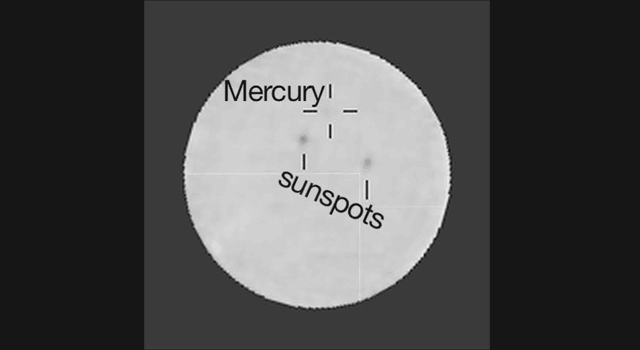
Because the sunspots move along with the rotation of the Sun (and the Sun rotates once avery 25 days around its equator) Mercury makes a fast pass as it travels along on one of its 88-day-long years.
Watch an HD version of the event here.
In reality this was no chance spotting, but rather a carefully calculated observation using the Mastcam’s right 100mm telephoto lens and neutral density filter, which is used to routinely image the Sun in order to measure the dustiness of the Martian atmosphere.
“This is a nod to the relevance of planetary transits to the history of astronomy on Earth. Observations of Venus transits were used to measure the size of the solar system, and Mercury transits were used to measure the size of the sun.”
– Mark Lemmon, Texas A&M University, member of the Mastcan science team
Read more: Amazing Transit of Venus Images from Around the World
The next chance for Curiosity to spot Mercury will come in April 2015 and, if the rover is still operating by then — perhaps with some upgrades by future human visitors? — it may capture Earth similarly passing across the Sun in November of 2084.
Source: NASA/JPL
Image/animation credit: NASA/JPL-Caltech/MSSS/Texas A&M
Virtual Star Party – February 23, 2014 – Nebulae, Sunspots, and Planet “X”?!?
Hosts: Fraser Cain & Scott Lewis
Astronomers: David Dickinson, Gary Gonella, James McGee, Mike Simmons, Roy Salisbury, Shahrin Ahmad, Tom Nathe
Tonight’s views:
Jupiter with a nice view of the red spot, Venus approaching zenith, Bubble Nebula, the Pleiades, Orion Nebula, Horsehead Nebula, Flame Nebula, Running Man Nebula, the Moon, the Sun, the ISS (photo), the Rosette Nebula, Orion again, M33, Sunspots, Rosette again, California Nebula (multiple views), M81 & M82, Planet “X” (?!?), Andromeda, Flame Nebula again
We hold the Virtual Star Party every Sunday night as a live Google+ Hangout on Air. We begin the show when it gets dark on the West Coast. If you want to get a notification, make sure you circle the Virtual Star Party on Google+. You can watch on our YouTube channel or here on Universe Today.
Virtual Star Party – February 16, 2014: Fighting Crime while Transiting Jupiter!
Hosts: Fraser Cain & Scott Lewis
Astronomers: David Dickinson, Gary Gonella, James McGee, Tom Nathe, Mike Phillips, Mike Simmons, Roy Salisbury, Shahrin Ahmad
Views tonight: Horsehead Nebula, Flame Nebula, Europa Transit of Jupiter with Great Red Spot, a cluster of sunspots, Rosette Nebula, a near-Earth asteroid, a capture of Barnard’s Loop, Orion Nebula, M81, various telescopes of the astronomers, our moon, another transit of Jupiter by one of the moons, M67, NGC 2169-the “37” Cluster, our moon – full view, California Nebula.
We hold the Virtual Star Party every Sunday night as a live Google+ Hangout on Air. We begin the show when it gets dark on the West Coast. If you want to get a notification, make sure you circle the Virtual Star Party on Google+. You can watch on our YouTube channel or here on Universe Today.
Giant sunspot convulses but all quiet on the aurora front … for now
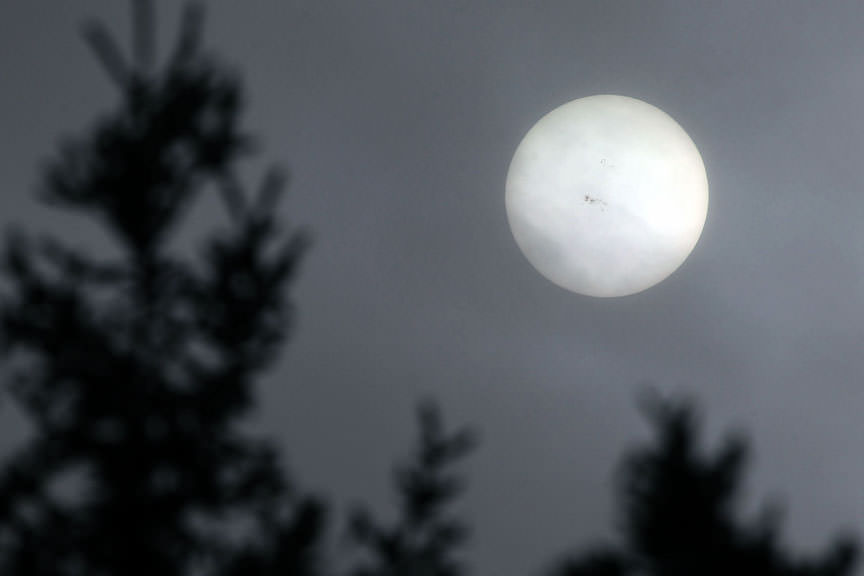
What a crazy sunspot cycle. Weeks go by with only a few tiny spots freckling the sun, then all at once a monster group big enough to swallow 10 Earths rounds the eastern limb and we’re back in business. I’m happy to report we’ve got another behemoth snapping and crackling with M-class (moderately strong) flares – Active Region 1967, a hunk-a-hunk of burnin’ funk that rounded the solar limb a week ago.
NOAA weather forecasters predict an 80% chance of continued M-flares and a 50% chance over the next 3 days for considerably more powerful X-class flares. This sunspot group has a delta classification magnetic field, the Facebook equivalent of “It’s complicated”.
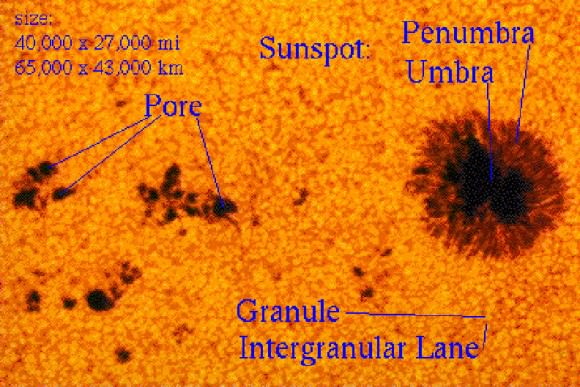
Sunspots have two parts: a dark core (or cores) called an umbra surrounded by a paler skirt of magnetic energy, the penumbra. They can look impressive like this one, but it’s hard to call a sunspot a “thing”. It’s really more of a locale on the sun’s bright white photosphere where bundles of powerful magnetic energy bob up from below the surface and insulate a region of the sun’s fiery hydrogen gas from the rest of the flaming globe.
We’re talking insulate as in staying cool. While the photosphere cooks at around 11,000 degrees Fahrenheit, sunspots are some 3,000 degrees cooler. That’s why they appear dark to the eye. If you could rip them away from the sun and see them alone against the sky, they’d be too bright to look at safely.
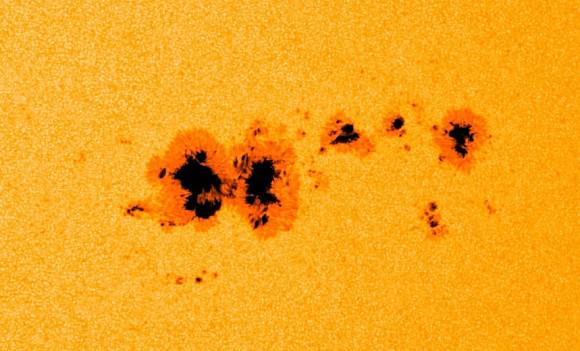
A delta-class spot group has umbrae of both polarities, north and south, corralled within the penumbra. Like bringing opposite poles of a two magnets so close they snap together, something similar can happen inside delta-class groups. Only instead of a snap, a titanic thermonuclear explosion called a flare goes kaboom.The biggest flares release the equivalent of a billion hydrogen bombs.
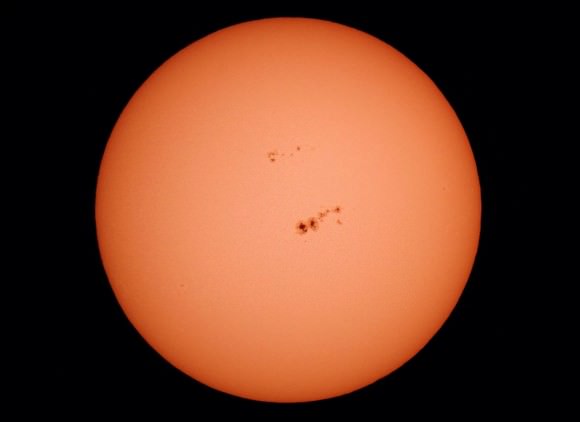
We thank our lucky stars for Earth’s iron heart, which generates our protective magnetic shield, and the 93 million miles that separate us from the sun. AR 1967 has paraded right in front of our noses as it rotated with the sun. Yesterday it squarely faced the Earth – a good thing when it comes to the particle blasts that fire up the northern lights. Let’s hope it showers us with a magnetic goodness in the coming days. I really miss seeing the aurora. You too? NOAA space weather forecasters are calling for a 25% chance of auroras in Arctic latitudes overnight Feb. 4-5. We at mid-latitudes will try to be patient.


